Tonettes, Song Flutes, Flutophones, and Precorders
An article on cheap plastic flutes? Surely I jest! Actually, no. There are a whole host of reasons to familiarize yourself with these instruments. For one, they've introduced tens of millions of American schoolchildren to music. You may remember tooting one yourself.
These simple flutes are inexpensive, easy to clean, portable, and nearly indestructible. Their biggest draw is that they're so easy to learn and to play. If you play concert flute, you'll be able to play any of them from the very moment you pick it up.
Given their wide classroom use, these flutes are often described as “pre-band instruments.” The idea is that kids start on an instrument that's as easy and fun as a toy in grade school and then graduate to concert instruments as they mature. 80 years of history proves this works.
But here's the best reason to explore these flutes. You might actually enjoy playing them! They're not just for kids. We'll listen to sound clips that prove these simple instruments can act as vehicles for true musical expression. It's amazing the music you can create with a ten-dollar flute.
History
The pre-band concept started in the late 1930s with the inventions of the tonette and the song flute. These little black flutes quickly became familiar to an entire generation of schoolchildren. Wikipedia claims that half the grammar schools in the nation used them by 1941. They became so popular that the U.S. Army distributed tonettes to military personnel during the Second World War.
Trophy's flutophone® joined the competition in 1943. The company claims their product has since been the introductory instrument for some 50 million children. Together, the flutophone, tonette, and songflute owned the market for pre-band instruments in the 1940s through the 1970s.
By the 1980s, things had changed. Inexpensive plastic recorders flooded the market. Today they totally dominate musical education. Yet many schools persist with the flutophone, song flute, and even the modern plastic ocarina.
Today, the tonette is long out of production. Song flutes and flutophones continue to be popular but no longer reign supreme in schools. And, Suzuki has introduced their precorder®, which to all appearances looks like an updated, modernized tonette.
In a companion article on this website, I'll discuss recorders, ocarinas, and other folk flutes. Here we'll focus on the traditional pre-band flutes.
Let's take a close look at tonettes, song flutes, flutophones, and precorders.
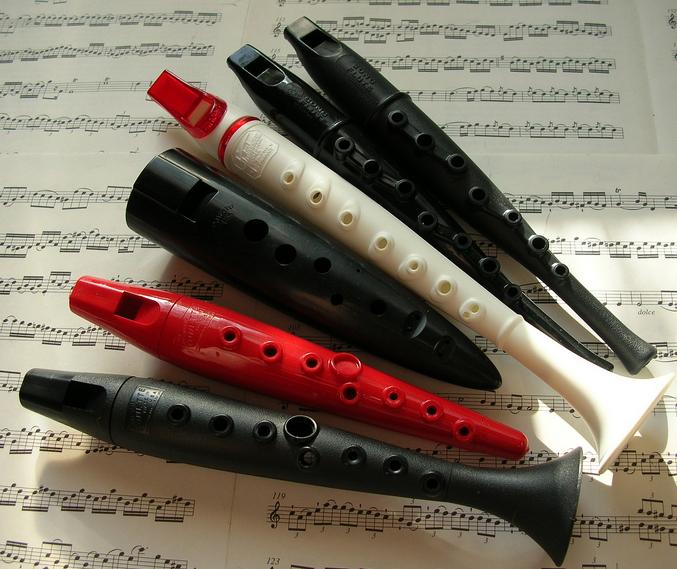
(photo courtesy of Andreas)
Tonettes
The tonette was invented in the late 1930s by Ziegner Swanson. A variety of companies have manufactured and sold them since including The Tonette Company, Chicago Musical Instrument Co., Swanson, Gibson, and Dimestore Dreams/Binary Arts Corp, and Restoration Hardware. On each instrument, a stamped imprint just below the mouthpiece identifies it as a tonette by the words “Tonette”, “Swanson”, or “Gibson”.
These photos at Ebay show how a variety of tonettes look. Over the decades they've been made in every color of the rainbow, yet for some reason, black predominates. They measure 7.5 to 8.5 inches long and a bit over an inch at their widest point. Most have a tapered end, though some feature a bell reminiscent of a clarinet.
It's important to note that all tonettes have closed ends. (Even those with the flared bell, which is purely decorative and serves no function.) Inspect the end of your plastic flute — if it has an open end, it is not a tonette.
The closed end means that tonettes are vessel flutes, instruments that rely on resonance within a closed air chamber for their voice. In fact, they're inline ocarinas, or vessel flutes that extend straight out from the mouth with a row of fingering holes.
This design is responsible for their unique timbre. Though they look like cylindrical bore flutes, tonettes sound more like the plastic ocarinas they are.
Some tonettes consist of a single piece of molded plastic and are not tunable. Most come with a removable mouthpiece. This permits tuning and easy cleaning with soap and warm water. A few even sport a removable bell or tail.
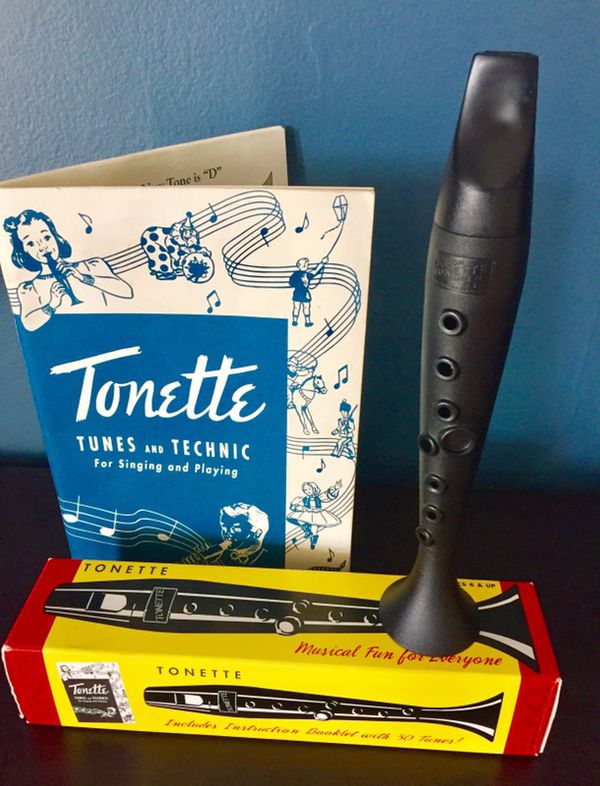
As with the three other instruments in this article, you progressively lift your fingers to play the scale. Finger holes are raised so they're easier for youngsters to fully cover than those of recorders with their flat, unadorned holes. The holes are close together for small hands. The goal is to make playing as easy and intuitive as possible.
The tonal range of the all instruments in this article is C5 through D6. That starts an octave higher than middle C on the piano (C4) and includes only 9 whole notes.
With tonettes you can easily extend that range two notes higher. You'll notice from the above photos that the instrument includes molded finger rests for your left hand pinky finger and your right hand thumb. Simply take a pen knife and carefully hollow out these two finger rests to transform them into holes. Now you've extended your range to C5 through F6.
Modification does not affect the instrument's sound beyond adding a couple extra notes. So why weren't they sold this way? My guess is that the designer believed the instrument was easier to learn without the two extra fingering holes.
Tonette sound quality varies. These flutes were manufactured over many decades by different companies using different molds. The best-sounding ones consist of a hard, dense plastic. They have a shiny, smooth, reflective surface and project a clear, lively voice. Many poor ones are made from a lightweight, textured plastic with either a non-reflective or black matte finish. These often date from the instrument's later years. Many sound too breathy or airy, more like a toy than musical instrument. Some have intonation issues.
My quality tonettes announce notes accurately. They play all sharps and flats between C5 and F6 except for low C# (you must half-hole to play this note). Fingering sharps and flats can vary across instruments due to slight differences in intonation. Like all ocarinas, tonettes require higher breath pressure to hit the highest notes in tune.
Let's listen to sound samples. Here's a short swing riff on a World War II army-issue tonette. This soulful rendition of “Amazing Grace” demonstrates the possibilities of the instrument in the right hands. (Note the shiny high-quality tonette in the video.) This rendition of Scarborough Fair shows how students can enjoy themselves while making decent music.
You can hear tonettes in professionally produced music in the Gross Concerto by P.D.Q. Bach. Then there's that psychedelic '60s classic, “Pressed Rat and Warthog,” by the rock group Cream. Listen to it here. Don't you just love those ethereal little flutes singing in the background?
Song Flutes
The song flute was invented in the late 1930s by Elver J. Fitchhorn. With its similar size, black plastic body, molded fipple, and raised fingerholes, it looks so like the tonette that people often confuse the two.
Yet there are differences. First, this flute is still actively produced and marketed by Conn-Selmer. (Conn and Selmer merged in 2003.) As you can see from Ebay photos, it carries the stamped identifier “Song Flute” and/or the maker's mark of Fitchhorn, Selmer, Conn-Selmer, or Conn.
Second, the instrument lacks the two dummy finger holes found on the tonette. You can't modify its pitch range. Like the flutophone and precorder, its range is limited to C5 through D6.
Third, the song flute features a long, gently flared tail. That's how you can distinguish it from a tonette. That tail is open-ended.
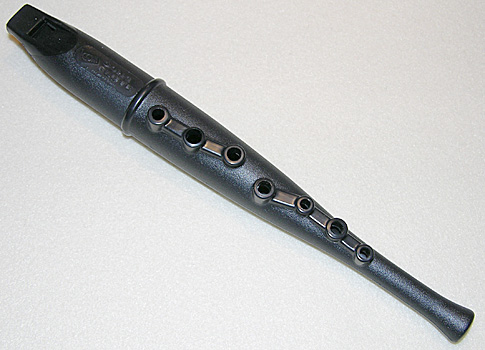
(photo courtesy of The OnMusic Dictionary)
Is it an ocarina? I'd say it's not a true vessel flute due to its open end. Others point out that the open end is so small (one-eighth of an inch) that the instrument still produces sound as a Helmholtz resonator. They claim the acoustical physics are more those of a chamber flute than a cylindrical bore flute.
Song flutes are molded from black plastic. Conn-Selmer advertises the instrument as always in tune due to its one piece construction. Those I've tried are in tune with themselves but of course you can't tune to other instruments without an adjustable mouthpiece.
Like the tonette, you have to half-hole to get low C#. This is difficult unless you're practiced.
How does it sound? Look closely and you'll see that not all song flutes look exactly the same. Older ones with a smooth, shiny, hard surface sound best. Newer ones with a slightly textured surface or matte finish often sound inferior. Exactly as with tonettes, manufacturers appear to have degraded the plastic at some point. My experience has been that the older, glossy material sounds better.
Here's a skilled musician showing what a song flute can do. His performance proves that even simple flutes can express musical beauty. Here's another Youtube clip that gives you a good idea how the instrument sounds.
If you'd like to try a song flute yourself, Amazon presently offers them at the rock-bottom price of about $5 USD. If quality sound is your goal, I recommend you seek a shiny-smooth older model on Ebay.
Flutophones
The flutophone® is an attractive two-color plastic instrument with an ornamental bell. Since its introduction in 1943, it has sold to the tune of 35 million.
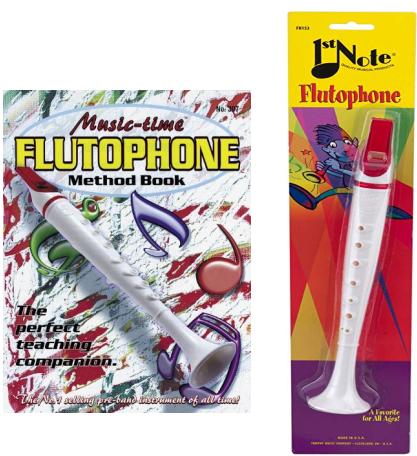
(photo courtesy of Amazon)
You can view various flutophones in these Ebay photos. The catchy dual-color scheme is either a white body with red decoration or a black body with white trim. This appeals more to the eye than black tonettes or song flutes. The separate mouthpiece allows you to tune and clean the instrument.
Like some tonettes, the flutophone features a decorative bell at its base. The bell doesn't appear to project sound. Inside it is a small hole. Given that these products are designed with young children in mind, I'd speculate that the little hole is there more to drain moisture than determine timbre. (Although if you cover it the sound suffers.)
Makers marks for the flutophone include Trophy, Grover-Trophy, 1st Note, Thompson, and Music Treasures Co. You might also encounter this instrument under the names, Trophy Horn or Alto Horn.
Fingering is nearly identical for the four flutes we're discussing, as this fingering chart shows. Some differences show up among the sharps and flats. Here's a fingering chart specifically for the flutophone that includes its full chromatics. Just like the other flutes in this article, half-tones require cross-fingering. The flutophone features a double-hole to help you play low C#, which neither the tonette or nor song flute provide. However it lacks the additional low D# hole of the precorder, so you must cross-finger that note.
And the sound? The one I toyed with years ago did not play in tune with itself as the lower notes were off-key. I see that several reviewers at Amazon mention this same concern. Yet many, many more reviewers rave about their flutophones.
Listen and decide for yourself. Here's a fun snippet of a speed flutist really going to town on his flutophone. This dexterous performance similarly demonstrates quick-fingered tunes. This original composition gives you a better idea of the flutophone's timbre and intonation.
Here's one of several videos that show how regular folks with everyday skills can employ the flutophone to create inventive, original music. That's the great benefit to humble folk instruments, isn't it? Access to creative tools at minimal cost. Fun for everyone!
And at Carnegie Mellon University, even a robot plays the flutophone. You can buy a flutophone for under $10.
Precorders
The newest competitor among pre-band flutes is the Suzuki Precorder®. The precorder looks like a modernized tonette. Its small open end perhaps makes it more like a song flute acoustically.
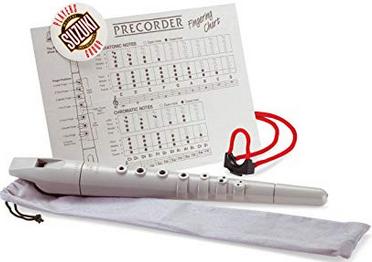
(photo courtesy of Amazon)
Like the flutophone, the precorder has a removable mouthpiece for tuning and cleaning. The translucent red and blue versions allow you to see if moisture has built up inside, so you can easily open up the instrument to dry it.
The precorder has double-holes on both low notes to make it easier to finger low C# and D#. And it's fully chromatic. Its fingering chart is more clear than most because it includes both diatonic notes and chromatics but does not confuse beginners by interspersing them.
Suzuki's well-thought-out precorder package comes complete with a cloth storage bag, neck strap, fingering chart, and stickers. Quite a deal for less than $10. It's my personal pick for young children from among the current pre-band flutes. You can learn more about it at Suzuki's product webpage.
Unlike tonettes, song flutes, or flutophones, which have evolved over the decades, all precorders are the same. Only Suzuki makes them and to my knowledge no variations exist. This is a big benefit to those who require product consistency, for example, in classroom teaching. It also means all precorders sound the same. Is that good?
The good news is that the instrument is tunable and includes all chromatics in its C5 to D6 range. It's easy to hit notes and stay in tune with proper intonation. The one challenging note is high D, which requires a little practice.
Overall I'd characterize the precorder's sound as mediocre. It's pretty breathy. It compares favorably to many of the late-issue tonettes and song flutes I've played. Yet it's nowhere near as pleasing to the ear as the better tonettes and song flutes. Playing in a location with natural resonance greatly enhances its appeal. Listen to this sample sound clip and this second sample clip to judge for yourself.
The precorder is designed for young children. Its so-so sound quality makes perfect sense if you review Suzuki's line of instruments. For just a few dollars more, you can opt for either their one-piece or three-piece beginner recorders. As the entry-level product, the precorder does a fine job fulfilling its role as a musical toy for kids.
Conclusion
These four plastic flutes make fun kids' toys and great first musical instruments. They're incredibly cheap, largely indestructible, kid-safe, portable, and about as easy to play as any instrument you can name. Their 80-year legacy proves their value.
These flutes are also legitimate vehicles for creating beautiful music. If you play other woodwinds, you'll be able to play them from the moment you pick them up. They give you fresh new sounds with which to experiment. If you're new to music, they're an incredibly easy way to get started. You'll be fingering tunes in no time.
For kids, I'd recommend Suzuki's precorder. For under $10 they get a complete package with a cloth carrying-bag, neck strap, fingering chart, and a kid-safe pre-band instrument.
For musicians, I recommend tonettes and song flutes made from the original glossy plastic. These project a uniquely appealing voice, especially when played in a hall or stairwell with natural resonance.
They are no longer manufactured so you'll have to buy them from a website that deals in used items, such as eBay. Be careful to avoid the plethora of poorly-made pieces that are more toy than instrument. I'd recommend purchasing a shiny black one made prior to 1970.
One fact is certain. These simple flutes all score high in nostalgia. Seeing one always brings a smile to those who recall them from their schooldays.
Summary Chart
| Tonette | Song Flute | Flutophone | Precorder | |
|---|---|---|---|---|
| Closed end | yes | no | no | no |
| Range | C5–F6* | C5–D6 | C5–D6 | C5–D6 |
| Chromatics | all but low C# | all but low C# | yes | yes |
| Low C# hole | no | no | yes | yes |
| Low D# hole | no | no | no | yes |
| Tunable | usually** | no*** | yes | yes |
| Colors | various; black common | black | white/red or black/white | red, blue, or gray |
| In production | no | yes | yes | yes |
| Manufacturer | none | Conn-Selmer | Grover-Trophy | Suzuki |
** Some tonettes are one-piece and non-tunable, others are two-piece and tunable.
*** All song flutes I've ever seen are black, one-piece, and not tunable, but I can't aver no historical variations exist.
About the Author
Howard Fosdick is a computer scientist who plays a variety of woodwinds. He researched and wrote this article when he discovered the paucity of information about these flutes on the web. You might be interested in his companion article on this website that contrasts recorders, ocarinas, tin whistles, and Native American flutes.